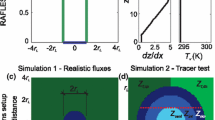Abstract
The dependency of the latent heat flux on the over-water fetch on lakes surrounded by tall, dense forest was studied by making use of measurements made on two different-sized lakes. The measurements were made during the NOPEX (Northern Hemisphere Climate-Processes Land Surface Experiment) field campaign. It was found that, in the case of a typical Scandinavian lake with a size of less than 10 km2, the latent heat flux will increase as a function of over-water fetch due to the increase of wind speed and in spite of the increased air humidity. This also has implications on area-averaged fluxes: when two lakes having similar shorelines, lake water temperatures and solar radiation conditions are compared, then the evaporation per unit area is smaller from the smaller lake. When the lakes are large, with fetches of several kilometres, then the significance of sheltering is small. If point measurements are used for the estimation of area-averaged latent heat fluxes from lakes with short fetches and forested shorelines then the distance of the measuring site from the shoreline should be taken into account, otherwise errors of tens of percent may occur.
Similar content being viewed by others
References
Brutsaert, W.: 1982, Evaporation into the Atmosphere, D. Reidel Publishing Company, Dordrecht, 299 pp.
Elliott, W. P.: 1958, ‘The Growth of the Atmospheric Internal Boundary Layer’, Trans. Am. Geophys. Union 39, 1048-1054.
Halldin, S., Gottschalk, L., van de Griend, A., Gryning, SE., Heikinheimo, M., Högström, U., Jochum, A., and Lundin, L.C.: 1995, ‘Science Plan for NOPEX’, Available from: NOPEX Central Office, Institute of Earth Sciences, Uppsala University, Norbyvägen 18 B, SE-752 36 Uppsala, Sweden, 42 pp.
Heikinheimo, M., Kanga, M., Tourula, T., Venäläinen, A., and Tattari, S.: 1997, ‘Momentum and Heat Fluxes over Lakes Tämnaren and Råksjön Based on Measurements by the Bulk Aerodynamic and Eddy-correlation Methods’, Agric. For. Meteorol., submitted.
Hipps, L. E. and Zehr, D. F.: 1995, ‘Determination of Evaporation from Integrated Profiles of Humidity and Temperature Over an Inhomogeneous Surface’. Boundary-Layer Meteorol. 75, 287-299.
Klaassen, W.: 1992, ‘Average Fluxes from Heterogeneous Vegetated Regions’, Boundary-Layer Meteorol. 58, 329-354.
Kwan J. and Taylor, P. A.: 1994. ‘On Gas Fluxes from Small Lakes and Ponds’, Boundary-Layer Meteorol. 68, 339-356.
Launiainen J. and Vihma, T.: 1990, ‘Derivation of Turbulent Surface Fluxes -An Iterative Flux-profile Method Allowing Arbitrary Observing Heights’, Environmental Software 5(3), 113-124.
Liu, J., Chen, T. A., and Novak, T. D.: 1996, E-∈ Modelling of Turbulent Air Flow Downwind of a Model Forest Edge', Boundary-Layer Meteorol. 77, 21-44.
McNaughton, K. G.: 1983, ‘The Direct Effect of Shelter on Evaporation Rates: Theory and Experimental Test’, Agric. For. Meteorol. 29, 125-136.
Panofsky, H. and Dutton, J. A.: 1984, Atmospheric Turbulence, John Wiley and Sons, 397 pp.
Raatikainen, M. and Kuusisto, E.: 1990, ‘The Number and Surface Area of the Lakes in Finland (abstract in English)’, Terra 102(2), 97-110.
Taylor, P. A. and Lee, R. J.: 1984, ‘Simple Guidelines for Estimating Wind Speed Variations due to Small Scale Topographic Features’, Climatol. Bull. 18(2), 3-32.
Tourula, T., Heikinheimo, M., Venäläinen, A., and Tattari, S.: 1996, ‘Micrometeorological Measurements on Lakes Tämnaren and Råksjön during CFE1 and CFE2’, Technical Report No. 24, 22 pp., Available from: NOPEX Central Office, Institute of Earth Sciences, Uppsala University, Norbyvägen 18 B, SE752 36 Uppsala, Sweden.
Venäläinen, A., Frecht, M., Heikinheimo, M., and Grelle, A.: 1997, ‘Latent and Sensible Heat Fluxes from Boreal Zone Lakes; Comparison with Fluxes from Forest and Influence on Regionally Averaged Values’, Agric. For. Meteorol., submitted.
Walmsley, J. L., Taylor, P. A., and Salmon, J. R.: 1989, ‘Simple Guidelines for Estimating Wind Speed Variations due to Small-Scale Topographic Features - an Update’, Climatol. Bull. 23(1), 3-15.
Wang, H. and Takle, E. S.: 1996, ‘On Efficiency of Shelterbelts in Oblique Wind’,Agric. For. Meteorol. 81, 95-116.
Rights and permissions
About this article
Cite this article
Venäläinen, A., Heikinheimo, M. & Tourula, T. Latent Heat Flux from Small Sheltered Lakes. Boundary-Layer Meteorology 86, 355–377 (1998). https://doi.org/10.1023/A:1000664615657
Issue Date:
DOI: https://doi.org/10.1023/A:1000664615657




